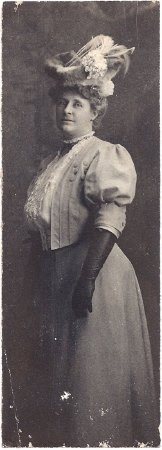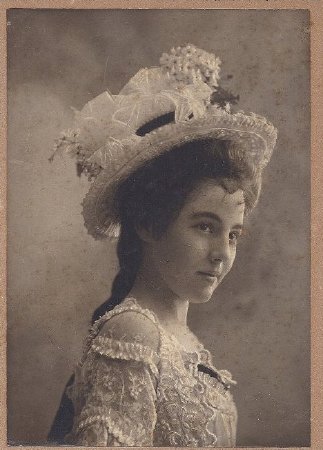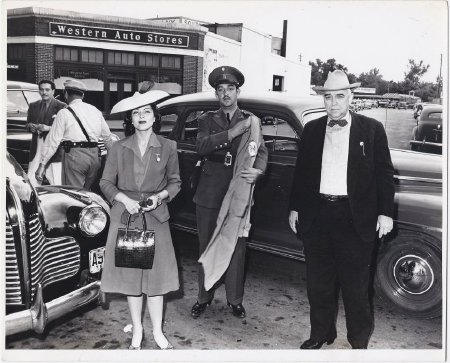Women's Hats
About this Image:
1) A studio portrait photograph of Mrs. Elise Groos Guenther (1866–1949). Elise was the oldest daughter of Gustav Groos (1832–1895), one of the three Groos brothers who started F. Groos and Company and Groos National Bank. She married Arthur William Guenther (1858–1931), also a banker and the founder of Liberty Flour Mills.
Large, elaborate hats prevailed at the turn of the century, like this one augmented by both feathers and flowers. In San Antonio, ladies could acquire ostrich feathers from local birds raised by F. G. Mierow at the Hot Wells Ostrich Farm just north of the popular health resort at Hot Wells. Egret plumes, another option, proved so popular nationwide that the snowy egret was driven to the brink of extinction in North America. Several major conservation efforts came about in response, including the creation of the National Audubon Society.
2) Minnie Schuchardt wears a loosely woven straw boater embellished with ribbon and clusters of flowers. In the first decade of the 1900s, a hat like this could have been viewed as quite subdued. Notice how the hat perches high and to the back of her upswept hair, adding considerable height to her appearance.
3) Fire and Police Commissioner Preston Anderson (1889-1952) stands next to visiting dignitaries. The woman wears a distinctive flying saucer-shaped hat, one of the many popular hat styles that contrasted with the more limited and sober wardrobe choices available during the war years. While hats and gloves remained part of the well-dressed woman's apparel well into the 1950s, the woman pictured appears with bare hands, possibly clutching her gloves.
Prior to serving as Commissioner, Anderson was elected to the Texas House of Representatives in 1926. As a legislator, he sponsored a bill to purchase land adjacent to the Alamo for the state of Texas. During his term as Commissioner, Anderson sought to close down San Antonio's red light district in an effort to protect soldiers stationed here.
Large, elaborate hats prevailed at the turn of the century, like this one augmented by both feathers and flowers. In San Antonio, ladies could acquire ostrich feathers from local birds raised by F. G. Mierow at the Hot Wells Ostrich Farm just north of the popular health resort at Hot Wells. Egret plumes, another option, proved so popular nationwide that the snowy egret was driven to the brink of extinction in North America. Several major conservation efforts came about in response, including the creation of the National Audubon Society.
2) Minnie Schuchardt wears a loosely woven straw boater embellished with ribbon and clusters of flowers. In the first decade of the 1900s, a hat like this could have been viewed as quite subdued. Notice how the hat perches high and to the back of her upswept hair, adding considerable height to her appearance.
3) Fire and Police Commissioner Preston Anderson (1889-1952) stands next to visiting dignitaries. The woman wears a distinctive flying saucer-shaped hat, one of the many popular hat styles that contrasted with the more limited and sober wardrobe choices available during the war years. While hats and gloves remained part of the well-dressed woman's apparel well into the 1950s, the woman pictured appears with bare hands, possibly clutching her gloves.
Prior to serving as Commissioner, Anderson was elected to the Texas House of Representatives in 1926. As a legislator, he sponsored a bill to purchase land adjacent to the Alamo for the state of Texas. During his term as Commissioner, Anderson sought to close down San Antonio's red light district in an effort to protect soldiers stationed here.
Credit:
Courtesy of San Antonio Conservation Society Foundation



